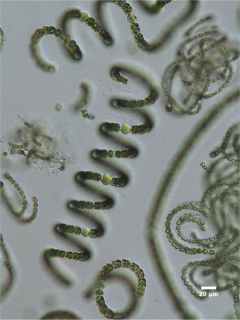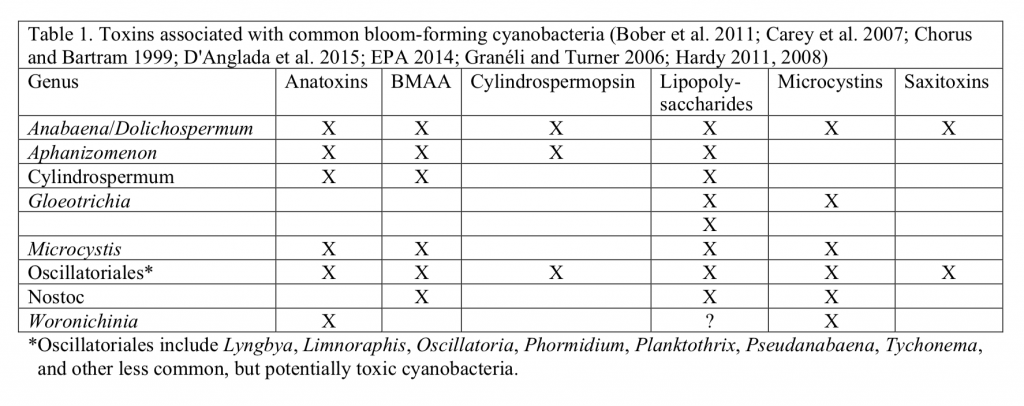Dr. Robin Matthews, Director, Institute for Watershed Studies, Huxley College of the Environment, Western Washington University
Many communities have experienced lake closures caused by toxic cyanobacteria blooms. Recent scientific studies suggest that the frequency and duration of cyanobacteria blooms has increased significantly over the past 200 years, especially since 1945 (Taranu et al. 2015). Not all cyanobacteria produce toxins, and not all blooms release harmful levels of toxins. But identifying which types of algae are potentially toxic and understanding the factors associated with toxic blooms are important steps in protecting the public from harmful blooms.
Cyanobacteria are found in almost every freshwater habitat, and exhibit a wide range of adaptations to different environmental conditions (Berg and Sutula 2015, Graham et al. 2017, Granáli and Turner 2006). Cyanobacteria can use both inorganic and organic forms of nitrogen and phosphorus for growth, and some can use dissolved nitrogen gas (nitrogen-fixing species). Many of the planktonic cyanobacteria have gas vesicles that allow them to move up and down in the water column, which increases their access to nutrients.
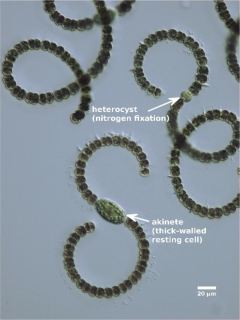
Toxic cyanobacteria blooms are most common during warm, calm weather in lakes and ponds with relatively high nutrient concentrations (nitrogen or phosphorus) or low nitrogen to phosphorus ratios (N:P<15). Not surprisingly, nutrient pollution and climate change appear to be related to the increasing frequency of toxic cyanobacteria blooms (Bennett 2017, Chapra et al. 2017, Paerl 2014). Although we normally associate toxic cyanobacteria blooms with biologically productive (eutrophic) lakes, toxic blooms have also been reported in unproductive (oligotrophic) lakes and other less obvious habitats. For example, blooms of Gloeotrichia echinulata have been reported in oligotrophic lakes in the northeastern U.S. (Carey et al. 2007).
In addition, toxic cyanobacteria do not always form planktonic blooms. Many non-planktonic cyanobacteria like Cylindrocystis, Hapalosiphon, Nostoc, and Phormidium, common on submerged surfaces or mixed with shoreline vegetation, have been found to produce toxins.
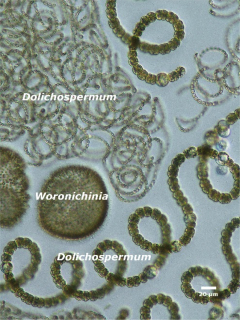
Toxic blooms often contain more than one species of cyanobacteria, so it can be difficult to identify which cyanobacteria are producing toxins. Until recently, toxicity was usually assigned indirectly, based on which species were most common in the bloom. But advances in algal culturing techniques and genetic analysis are rapidly filling in the missing information about which species can produce the different types of toxins.
Cyanobacteria toxins fall into three broad categories: nerve toxins (e.g., anatoxins, saxitoxins, beta-methylamino-L-alanine or BMAA); liver toxins (e.g., cylindrospermopsin, microcystins); and skin irritants (e.g., lipopolysaccharides). Table 1 lists some of the toxins that can be formed by the most common bloom-forming cyanobacteria in Washington lakes. The Washington State Department of Health (Hardy 2008, 2011) lists recreational guidelines for anatoxin-a (1 g/L), cylindrospermopsin (4.5 g/L), microcystin-LR (6 g/L), and saxitoxin (75 g/L), used to determine whether a cyanobacteria bloom presents a risk to the public.
Because of the growing concern over potential health risks associated with exposure to cyanotoxins, the U. S. Environmental Protection Agency has developed the Cyanobacteria Monitoring Collaborative (http://cyanos.org), a three-tiered approach to help train citizen scientists interested in identifying and monitoring cyanobacteria blooms. The website describes options for tracking cyanobacteria blooms using a smartphone or tablet (Bloomwatch); photographing cyanobacteria in blooms and uploading the images to the cyanoScope page on iNaturalist.org; and collecting water quality data to track seasonal patterns of cyanobacteria blooms in specific lakes. The information collected for this project is being used to develop a better understanding of when and where cyanobacteria blooms are likely to occur.
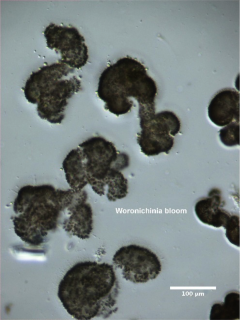 For more local information, the Washington State Department of Health and the Department of Ecology maintain an excellent online toxic algae website (https://www.nwtoxicalgae.org) that includes a photo gallery of toxic species, instructions on how to report suspected toxic blooms, and a searchable database that lists the toxicity results from lakes tested for cyanobacteria toxins.
For more local information, the Washington State Department of Health and the Department of Ecology maintain an excellent online toxic algae website (https://www.nwtoxicalgae.org) that includes a photo gallery of toxic species, instructions on how to report suspected toxic blooms, and a searchable database that lists the toxicity results from lakes tested for cyanobacteria toxins.
If you want to learn more about cyanobacteria, WALPA will offer a cyanobacteria identification workshop at the OLA/WALPA Joint Lakes Conference September 26-28 in Portland (see related article).
Literature Cited
Bennett, L. 2017. Algae, cyanobacteria blooms, and climate change. Climate Institute Report, April 2017.
Berg, M. and M. Sutula. 2015. Factors affecting the growth of cyanobacteria with special emphasis on the Sacramento-Jan Joaquin Delta. Southern California Coastal Water Research Project Technical Report 869.
Bober, B., Z. Lechowski, and J. Bialczyk. 2011. Determination of some cyanopeptides synthesized by Woronichinia naegeliana (Chroococcales, Cyanophyceae). Phycological Research 59:286-294.
Carey, C. C., J. F. Haney, and K. L. Cottingham. 2007. First report of microcystin-LR in the cyanobacterium Gloeotrichia echinulata. Environ. Tox. 22:337-339.
Chapra, S. C., B. Boehlert, C. Fant, V. J. Bierman, Jr., J. Henderson, D. Mills, D. M. L. Mas, L. Rennels, L. Jantarasami, J. Martinich, K. M. Strzepek, and H. W. Paerl. 2017. Climate change impacts on harmful algal blooms in U. S. freshwaters: a screening-level assessment. Envi. Science & Tech.51: 8933-8943.
Chorus, I. and J. Bartram (Eds). 1999. Toxic cyanobacteria in water: a guide to their public health consequences, monitoring and management. The World Health Organization E & FN Spon, London.
D’Anglada, L., J. Donohue, J. Strong, and B. Hawkins. 2015. Health effects support document for the cyanobacterial toxin anatoxin-A. U.S. Environmental Protection Agency, Office of Water, EAP-820R15104, June 2015.
EPA. 2014. Cyanobacteria and Cyanotoxins: Information for Drinking Water Systems. U. S. Environmental Protection Agency, Office of Water, EPA-810F11001.
Graham, L. E., J. M. Graham, L. W. Wilcox, and M. E. Cook. 2016. Algae, Third Ed., ver 3.3.1 . LJLM Press, ww.ljlmpress.com.
Granéli, E. and J. T. Turner (Eds.) 2006. Ecology of Harmful Algae. Ecological Studies, Vol. 189, Springer.
Hardy, J. 2008. Washington State Provisional Recreational Guidance for Microcystins (Provisional) and Anatoxin-a (Interim/Provisional). Washington State Department of Health, Olympia, WA
Hardy, J. 2011. Washington State Provisional Recreational Guidance for Cylindrospermopsin and Saxitoxin. Washington State Department of Health, Olympia, WA
Paerl, H. W. 2014. Mitigating harmful cyanobacterial blooms in a human- and climatically-impacted world. Life 2014 4:988-1012.
Taranu, Z. E., I. Gregory-Eaves, P. R. Leavitt, L. Bunting, T. Buchaca, J. Catalan, I. Domaizon, P. Guilizzoni, A. Lami, S. McGowan, H. Moorhouse, G. Morabito, F. R. Pick, M. A. Stevenson, P. L. Thompson, R. D. Vinebrooke. 2015. Acceleration of cyanobacterial dominance in north temperate-subarctic lakes during the Anthropocene. Ecology Letters, Volume 18(4): 375–384.

